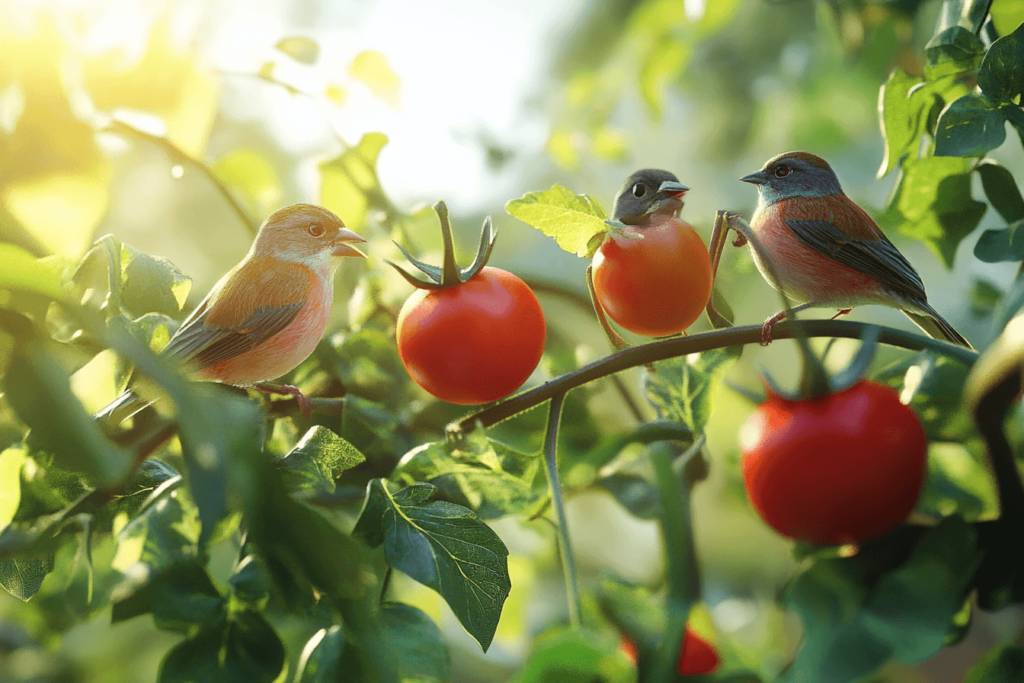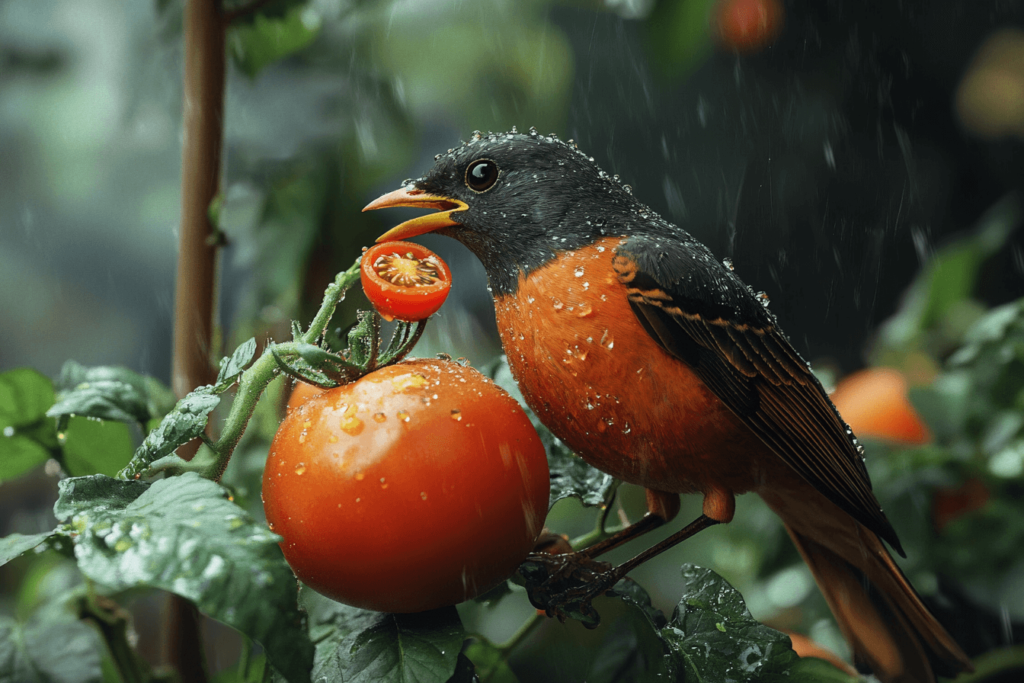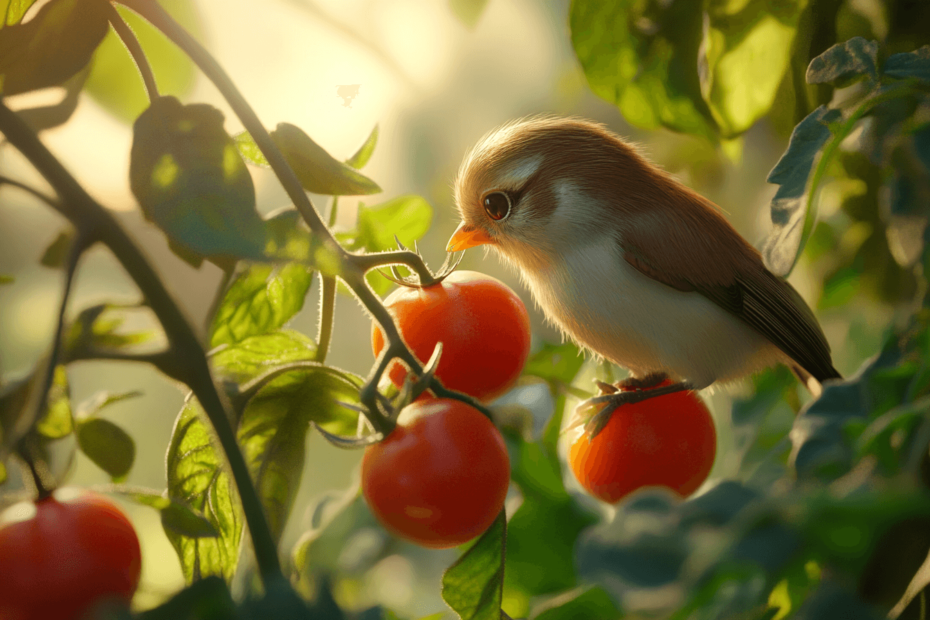Introduction
As a lifelong gardener and certified Master Gardener with over 20 years of experience, I’ve faced my fair share of challenges in the vegetable patch. But few issues have been as persistent and frustrating as birds eating my prized tomatoes. Through years of trial and error, research, and collaboration with fellow gardeners, I’ve developed a comprehensive strategy for keeping birds from devouring my tomato crop. In this guide, I’ll share my personal experiences and hard-won knowledge to help you protect your tomatoes from our feathered friends.
The Tomato Grower’s Dilemma
There’s nothing quite like the satisfaction of biting into a sun-warmed, homegrown tomato. I still remember the first time I harvested a perfectly ripe Brandywine tomato from my garden. The rich, complex flavor was a revelation – nothing like the bland supermarket varieties I was used to. That moment sparked a lifelong passion for tomato growing.
However, my journey as a tomato enthusiast hasn’t been without its challenges. Chief among them has been the constant battle to keep birds from eating my tomatoes. I’ve experienced the heartbreak of coming out to my garden, excited to harvest my first ripe tomatoes of the season, only to find them pecked and ruined by birds.
Over the years, I’ve learned that protecting your tomato crop from birds is not just about preserving your harvest – it’s about safeguarding the time, effort, and love you’ve invested in your garden. In this guide, I’ll share everything I’ve learned about how to keep birds from eating tomatoes, so you can enjoy the fruits of your labor.
How to Keep Birds from Eating Tomatoes?
To effectively protect our tomatoes, we first need to understand why birds are attracted to them in the first place. This knowledge has been crucial in my own garden, helping me develop more targeted and effective strategies.
Nutritional Value of Tomatoes for Birds
Tomatoes are not just delicious to us humans – they’re also a nutritious treat for birds. They’re rich in:
- Water content (especially important during dry spells)
- Vitamins A and C
- Lycopene (an antioxidant)
- Natural sugars
In my observations, I’ve noticed that birds seem particularly drawn to tomatoes during dry periods. One scorching summer, my birdbath had run dry, and I found my tomatoes pecked more than usual. This experience taught me the importance of providing alternative water sources for birds.

Types of Birds That Commonly Eat Tomatoes
In my garden, I’ve identified several culprits when it comes to tomato theft. The most common offenders include:
- Robins
- Mockingbirds
- Blue Jays
- Finches
- Starlings
Each species has its own feeding habits and preferences. For example, I’ve noticed that robins tend to go for tomatoes that are lower to the ground, while blue jays are bold enough to attack fruits higher up on the plant.
When Birds Are Most Likely to Target Tomatoes
Through careful observation, I’ve identified peak times when birds are most likely to raid my tomato patch:
- Early morning (just after sunrise)
- Late afternoon (a couple of hours before sunset)
- When there are few alternate sources of water during dry times
- When fruits are just beginning to ripen (birds often peck at tomatoes that are starting to turn color)
Understanding these patterns has allowed me to concentrate my protection efforts during these critical times.
III. Signs That Birds Are Eating Your Tomatoes
Identifying bird damage early can save your crop. Over the years, I’ve become adept at spotting the telltale signs of avian invaders in my tomato patch.
Visual Indicators of Bird Damage
Here’s what I look for when inspecting my tomatoes:
- Small, shallow pecks: Unlike insect damage, bird pecks are usually larger and more irregular.
- Partially eaten fruits: Birds often leave behind partially consumed tomatoes.
- Missing fruits: Sometimes, especially with cherry tomatoes, the entire fruit may disappear.
- Scattered seeds: Birds may peck out seeds, leaving them scattered around the plant.
I once mistook bird damage for insect infestation and wasted time applying ineffective treatments. I learned from this experience how crucial accurate identification is.
Differentiating Bird Damage from Other Pests
It’s crucial to distinguish bird damage from other common tomato pests. Here’s a quick comparison based on my observations:
| Pest | Damage Pattern |
|---|---|
| Birds | Large, irregular pecks; partially eaten fruits |
| Insects | Small holes; leaf damage; tunneling |
| Rodents | Large bite marks; fruits often carried away |
| Disease | Discoloration; wilting; spotted leaves |
Identifying the Specific Birds Causing Problems
Knowing which birds are targeting your tomatoes can help you tailor your protection strategies. I’ve found the following methods helpful:
- Direct observation (early morning and late afternoon are best)
- Setting up a wildlife camera
- Looking for feathers or droppings near damaged fruits
- Listening for bird calls in your garden
By identifying mockingbirds as my primary culprits one season, I was able to use targeted deterrents that were particularly effective against this species.
IV. Physical Barriers to Keep Birds from Eating Tomatoes
In my experience, physical barriers are often the most effective method for protecting tomatoes from birds. They create a tangible obstacle that birds can’t easily overcome.
Netting Solutions
Bird netting has been a game-changer in my garden. Here’s what I’ve learned:
- Choose the right mesh size: I use 3/4 inch mesh, which is small enough to keep out most birds but large enough to allow beneficial insects through.
- Proper installation is key: I secure the netting at ground level and use support structures to keep it from resting directly on the plants.
- Regular inspection is necessary: I check my netting weekly for any holes or gaps.
One year, I neglected to secure my netting properly, and crafty blue jays found their way underneath. Now, I’m meticulous about installation, and it’s paid off in protected tomatoes.

Row Covers and Tunnels
For smaller tomato patches, I’ve had success with row covers and tunnels:
- Lightweight fabric row covers: These allow light and water through while keeping birds out.
- Plastic tunnels: These provide protection and can extend the growing season in cooler climates.
I particularly like using row covers early in the season to protect young plants. As the plants grow, I transition to taller protective structures.
Bird-Proof Cages and Enclosures
For maximum protection, nothing beats a dedicated tomato enclosure. I built my own using these materials:
- PVC pipes for the frame
- Chicken wire for the sides
- Bird netting for the top
This setup has been incredibly effective, providing complete protection while still allowing easy access for maintenance and harvesting.
Pros and Cons of Physical Barriers
Based on my experience, here’s a quick rundown of the advantages and disadvantages of physical barriers:
Pros:
- Highly effective when properly installed
- Provide protection against multiple pests (not just birds)
- Can be reused for multiple seasons
Cons:
- Initial setup can be time-consuming
- May impact the aesthetic of your garden
- Can make harvesting and plant maintenance more challenging
Despite the drawbacks, I’ve found that the peace of mind provided by physical barriers is well worth the effort.
V. Visual Deterrents to Protect Tomatoes from Birds
While not as foolproof as physical barriers, visual deterrents can be an effective part of an integrated bird protection strategy. I’ve experimented with various visual deterrents over the years, with mixed results.
Reflective Tape and CDs
One of my first attempts at bird deterrence involved hanging old CDs around my tomato plants. The idea is that the reflective surface and movement will scare birds away. Here’s what I’ve learned:
- Effectiveness varies: Some birds seem deterred, while others quickly adapt.
- Movement is key: I’ve found that CDs or reflective tape that can move in the wind are more effective than stationary objects.
- Regular repositioning helps: Birds can become accustomed to stationary deterrents, so I move them every few days.
While not a standalone solution, I still use reflective elements as part of my overall strategy, especially for smaller garden areas.
Scarecrows and Decoy Predators
The classic scarecrow has been a staple in gardens for centuries, and for good reason. In my experience:
- Realistic predator decoys work best: I’ve had success with plastic owls and hawks.
- Movement enhances effectiveness: I use a decoy owl with a rotating head for added realism.
- Regular relocation is crucial: I move my decoys every few days to prevent birds from getting used to them.
I remember one particularly clever mockingbird that seemed to mock my static scarecrow. After switching to a more realistic, movable decoy, I noticed a significant decrease in bird activity around my tomatoes.
Colorful Balloons and Pinwheels
Bright colors and movement can be effective bird deterrents. I’ve experimented with:
- Red and yellow balloons: These colors seem to be particularly off-putting to birds.
- Pinwheels: The movement and reflection can startle birds.
- Reflective bird diverters: These spiral devices catch the light and create movement.
I’ve found these methods to be most effective when combined with other deterrents and regularly moved around the garden.
Effectiveness of Visual Deterrents
In my experience, the effectiveness of visual deterrents can vary greatly depending on the bird species, garden layout, and consistency of application. Here’s a quick breakdown of what I’ve observed:
| Deterrent | Effectiveness | Longevity of Effect | Ease of Use |
|---|---|---|---|
| Reflective tape/CDs | Moderate | Short-term | Easy |
| Scarecrows/Decoys | High (initially) | Medium-term | Moderate |
| Balloons/Pinwheels | Low to Moderate | Short-term | Easy |
Remember, visual deterrents work best as part of a multi-faceted approach to bird control.
VI. Sound-Based Methods to Deter Birds from Tomatoes
Sound can be a powerful tool in keeping birds away from your tomatoes. Over the years, I’ve experimented with various audio deterrents, each with its own pros and cons.
Electronic Bird Repellent Devices
These devices emit predator calls or distress signals to scare away birds. My experience with them has been mixed:
- Effectiveness varies by species: Some birds seem more affected than others.
- Can be annoying to humans: The constant sounds can be disruptive, especially in small gardens.
- Birds may habituate over time: I’ve found that changing the sounds and patterns regularly helps maintain effectiveness.
I once used an electronic repellent that mimicked a hawk’s cry. It was remarkably effective for the first few weeks, but I noticed the local birds gradually returning. Now, I use these devices sparingly and rotate them with other methods.
Wind Chimes and Other Noise Makers
Simple noise makers can be surprisingly effective:
- Wind chimes: The random, metallic sounds can startle birds.
- Aluminum pie plates: Hung on strings, these create unpredictable noises and reflections.
- Bells: Small bells attached to plants can ring when birds land, scaring them off.
I’ve found these methods particularly useful for smaller garden areas. In my herb garden, a set of copper wind chimes has been remarkably effective at keeping birds away from my cherry tomato plants.
Ultrasonic Bird Repellers
These devices emit high-frequency sounds that are supposed to be unpleasant to birds but inaudible to humans. My experience with them has been:
- Limited effectiveness: Some birds seem unaffected.
- Potential impact on pets: Dogs and cats may be sensitive to these frequencies.
- Can be expensive: Quality ultrasonic repellers often come with a high price tag.
While I haven’t found ultrasonic repellers to be a magic bullet, they can be a useful part of an integrated pest management strategy.

Pros and Cons of Sound-Based Deterrents
Based on my years of experimentation, here’s how I view the various sound-based methods:
Pros:
- Can cover a large area
- Non-physical barrier allows easy access to plants
- Some methods (like wind chimes) can be aesthetically pleasing
Cons:
- May disturb neighbors or household members
- Effectiveness can decrease over time as birds habituate
- Some methods require power sources or regular maintenance
In my garden, I use sound-based deterrents as part of a rotating strategy, never relying on them exclusively.
VII. Natural and Chemical Repellents for Bird Control
While I generally prefer non-chemical methods, there are times when repellents can be a useful tool in protecting tomatoes from birds. Over the years, I’ve experimented with both natural and commercial repellents.
Homemade Spray Solutions
I’ve tried several homemade repellents with varying degrees of success:
- Chili pepper spray: Mix hot pepper flakes with water and a drop of biodegradable soap. Spray on tomatoes and surrounding leaves.
- Garlic spray: Blend garlic cloves with water, strain, and spray.
- Vinegar solution: Mix equal parts water and white vinegar.
These sprays can be effective, but they need frequent reapplication, especially after rain. I’ve found the chili pepper spray to be particularly effective, but be careful – it can irritate your eyes and skin during application!
Commercial Bird Repellent Sprays
There are several commercial repellents available. In my experience:
- Methyl anthranilate-based sprays: These grape-flavored repellents are non-toxic and can be effective.
- Polybutene gels: These sticky substances discourage birds from landing but can be messy to apply and remove.
I’ve had moderate success with commercial sprays, but I always make sure to choose products that are safe for edible plants and follow the application instructions carefully.
Planting Companion Plants to Deter Birds
Certain plants can help repel birds naturally. I’ve incorporated these into my garden design:
- Marigolds: Their strong scent can deter some birds.
- Nasturtiums: These flowers are said to confuse birds with their bright colors.
- Lavender: Its strong fragrance may help keep birds away.
While not a standalone solution, I’ve found that integrating these plants throughout my tomato patch has contributed to an overall reduction in bird activity.
Safety Considerations for Repellents
When using any repellent, safety should be your top priority. Here are some guidelines I always follow:
- Read labels carefully: Ensure any product is safe for use on edible plants.
- Wear protective gear: Gloves and eye protection are essential when applying sprays.
- Reapply as directed: Most repellents need regular reapplication to remain effective.
- Wash tomatoes before eating: Even with natural repellents, it’s important to rinse your harvest thoroughly.
Remember, the goal is to deter birds, not harm them or compromise the safety of your tomatoes.
VIII. Providing Alternative Food Sources for Birds
One of the most effective and harmonious ways I’ve found to protect my tomatoes is by providing birds with alternative food sources. This approach allows me to enjoy both my tomato harvest and the presence of birds in my garden.
Setting Up Bird Feeders Away from Tomato Plants
Strategically placed bird feeders can draw birds away from your tomatoes. Here’s what I’ve learned:
- Distance matters: Place feeders at least 20-30 feet away from your tomato plants.
- Choose appropriate feed: Offer foods that appeal to the bird species in your area. I use a mix of sunflower seeds, millet, and nyjer seeds.
- Consistent supply: Keep feeders well-stocked to maintain birds’ interest.
I remember the year I first implemented this strategy – I was amazed to see the local birds contentedly visiting my new feeder station instead of pecking at my tomatoes.
Growing Sacrificial Plants for Birds
Another effective strategy is planting “decoy” crops that birds find attractive:
- Sunflowers: Birds love the seeds, and they’re easy to grow.
- Berry bushes: Blueberries or elderberries can provide a feast for birds.
- Fruit trees: If you have space, fruit trees can be a major attraction for birds.
In my garden, I’ve dedicated a corner to bird-friendly plants. It’s become a lovely feature in its own right, and it’s definitely reduced the pressure on my tomatoes.
Creating a Bird-Friendly Area in Another Part of Your Garden
By designating a specific area for birds, you can create a win-win situation. Here’s how I’ve done it:
- Install a birdbath for a water source
- Plant native species that provide natural food and shelter
- Add perches or small trees for birds to rest
- Maintain this area consistently to keep it attractive to birds
This approach has not only helped protect my tomatoes but has also increased the overall biodiversity in my garden. I now enjoy birdwatching as much as I do tomato growing!
IX. Cultural Practices to Reduce Bird Damage
In addition to the various deterrents and barriers, adjusting some of your gardening practices can help minimize bird damage to your tomato plants. Over the years, I’ve discovered several cultural strategies that have contributed to safeguarding my tomatoes.
Adjusting Planting Techniques
The way you plant and care for your tomatoes can make a significant difference in reducing bird attraction:
- Interplanting: Mix tomato plants with other crops that are less appealing to birds. I often plant herbs like basil or parsley nearby, which can mask the scent and appearance of tomatoes.
- Staggered Planting: Plant tomatoes at different times so that not all your fruits ripen simultaneously. This reduces the temptation for birds to feast on a large number of ripe tomatoes all at once.
- Dense Planting: By planting tomatoes closer together, it creates a more challenging environment for birds to navigate, thus reducing their access.
Timing and Harvesting
Being strategic about when you plant and harvest can also deter birds:
- Early Harvesting: Pick tomatoes as soon as they begin to show color and allow them to ripen indoors. This prevents birds from getting to them while they’re still on the vine.
- Staggered Harvesting: Regularly check your plants and pick ripe tomatoes daily. This reduces the number of fruits available for birds to peck at.
- Timing Planting: Consider the timing of your planting so that fruit ripening does not coincide with peak bird activity periods in your area.
Enhancing Natural Predation
Encouraging natural predators of birds can also help:
- Owls and Raptors: Encourage these natural bird predators by providing nesting boxes or perches around your garden.
- Domestic Animals: If you have a dog or cat, allowing them to patrol the garden can help deter birds from getting too close to your tomatoes.
X. Integrated Pest Management (IPM) for Bird Control
Integrated Pest Management (IPM) involves combining multiple strategies for a comprehensive approach to pest control. In my garden, I’ve found that a multi-pronged approach is the most effective way to protect tomatoes from birds.
Combining Multiple Strategies
The key to IPM is combining several deterrent methods to cover all bases:
- Physical Barriers + Visual Deterrents: Use netting in conjunction with scarecrows and reflective tape for double protection.
- Sound-Based Deterrents + Natural Repellents: Implement sound devices alongside homemade sprays to maximize effectiveness.
- Alternative Food Sources + Cultural Practices: While feeding birds away from your garden, simultaneously adjust planting and harvesting techniques.
Monitoring and Adaptation
Regular monitoring and adaptation are crucial for success:
- Regular Monitoring: Keep a close eye on bird activity and adjust your methods as needed. This might involve increasing the number of deterrents during peak bird activity times.
- Adapting Techniques: Birds can become accustomed to certain deterrents, so be prepared to rotate or combine strategies for continued effectiveness.
- Documenting Successes and Failures: Keep a gardening journal to track what works and what doesn’t. Over time, this will help refine your approach and improve your garden’s defenses.
Seasonal Adjustments
Adjust your methods with the changing seasons:
- Spring/Summer: Focus on physical barriers and netting when birds are most active.
- Fall/Winter: Utilize visual and sound deterrents when fruits are less abundant, but birds are still present.
Conclusion: Enjoying Your Tomato Harvest
By applying the strategies outlined in this guide, you can enjoy a bountiful tomato harvest while maintaining a balanced ecosystem in your garden. Remember, protecting your tomatoes from birds is a continuous effort that requires observation, adaptation, and sometimes a little creativity.
Through my experiences, I’ve learned that while birds can be persistent, they are not unbeatable. By understanding their behavior, providing alternative resources, and using a combination of deterrents, you can protect your precious tomato crop. Embrace the challenge, learn from each season, and soon enough, you’ll be savoring the sweet taste of victory with every bite of your homegrown tomatoes.
